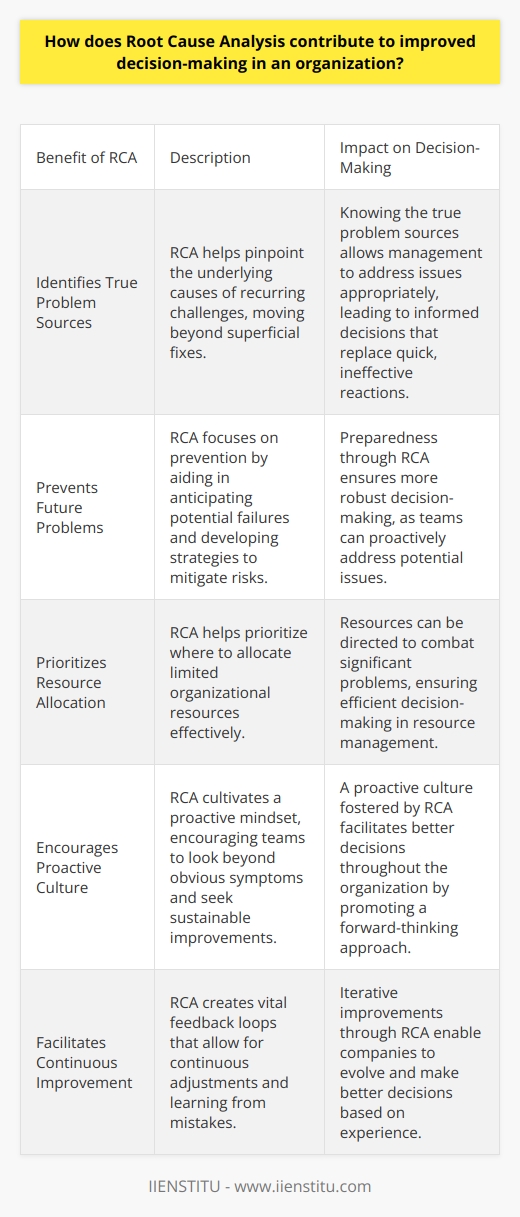
Root Cause Analysis (RCA) is a systematic method used to identify the underlying causes of faults or problems. By focusing on the origin of issues rather than their symptoms, RCA seeks to prevent recurrence by implementing effective solutions. The importance of Root Cause Analysis cannot be overstated, as it serves as a critical tool in decision-making processes across various industries.
Incorporating thorough analysis techniques ensures that resolutions are not merely temporary fixes but are sustainable changes that enhance overall operational efficiency. This blog post delves into the significance of RCA, providing insights into its methodology, tools, applications, and future within the context of organizational decision-making.
Understanding Root Cause Analysis
Derivation and Definition of RCA
At its core, Root Cause Analysis is a problem-solving method that aims to track down the primary cause of a problem or fault. The premise of RCA is that dealing with the foundational issue will naturally help prevent the problem from recurring and mitigate its effects more efficiently than by merely addressing its immediate outcomes. By identifying and addressing the root causes, organizations can improve their systems and processes, leading to significant long-term benefits.
Origin and Usage in Different Industries
Historically, Root Cause Analysis has found its origins in the fields of engineering and quality control. However, its applicability has broadened over time, finding relevance in sectors ranging from healthcare to information technology. In each of these sectors, RCA has been adapted and refined to meet distinct challenges, yet the underlying principle remains consistent: to uncover the source of problems and prevent repeats.
Explanation of Terms Associated with RCA
In the lexicon of RCA, terms such as "causal factor," "corrective action," and "preventive measure" are often used. A causal factor contributes directly to the occurrence of an issue, while corrective actions are the steps taken to rectify the identified problem. Preventive measures, on the other hand, are the strategies implemented to avert future incidents. Understanding these and other associated terms is fundamental to conducting an effective RCA.
The Need for Root Cause Analysis
Pareto Chart: A Powerful Tool for Data Analysis and Decision-Making
Developing Problem Solving Skills: Lessons from Saint Augustine
Tolerance Analysis: Strategic Approaches, Benefits and Challenges
Discuss the Problems Solved by RCA
Root Cause Analysis serves as a beacon of hope for organizations drowning in recurring problems. Whether it's a manufacturing defect leading to product recalls or a security breach in an IT firm, RCA provides a structured approach to problem-solving that goes beyond mere symptom treatment. It shines a light on issues that, if left unresolved, could have lasting impacts on an organization's performance and reputation.
The Significance of RCA in Solving Complex Problems
In tackling complex problems where the causes are multifaceted and deeply embedded, Root Cause Analysis serves an indispensable role. It provides a road map for dissecting and understanding the layers of the problem, allowing for tailored and impactful solutions. It moves the focus from reactive to proactive management.
Discussion on the Impact of Not Implementing RCA
Without RCA, organizations often find themselves in a loop of 'quick fixes' that fail to provide lasting solutions. The absence of a root cause approach can result in increased costs, reduced productivity, and damage to customer trust. Thus, investing time and resources in Root Cause Analysis is not merely a choice but a necessity for those seeking long-term efficiency and stability.
The Process of Root Cause Analysis
Step by Step Breakdown of the RCA Process
The RCA process is methodical, requiring careful attention and patience. It typically starts with the identification of the problem, followed by the gathering of data. Once the initial analysis is done, the team delves deeper into the potential causes, eventually identifying the root cause, which is then systematically addressed through developed solutions.
Identification of the Problem
The first step in RCA is to pinpoint the exact nature of the issue at hand. This involves not just recognizing that a problem exists, but also understanding the extent of its impact on the organization's operations.
Understanding the Problem Context
Understanding the context in which the problem occurs is crucial for framing the scope of the RCA. This involves considering the systems, processes, and individuals involved and how they might contribute to the occurrence of the issue.
Identifying the Root Cause
Determining the root cause or causes requires investigation and analysis. Techniques such as the Five Whys or Fishbone Diagram can be employed to dig deeper into the reasons behind the problem.
Developing and Implementing Solutions
Once the root cause is identified, the next steps are to develop and then implement solutions to address it. These solutions should be well-thought-out and tested to ensure they resolve the foundational issues effectively.
Reviewing the Effectiveness of the Solutions
Finally, the efficacy of the implemented solutions must be reviewed. This step ensures that the problem has been effectively addressed and helps refine the solutions if they fall short.
Tools Used in Root Cause Analysis
Overview of Various RCA Tools
There are various tools within the arsenal of Root Cause Analysis, each with its strengths. Familiarity with these tools enriches the analyst's ability to find the true causes of problems.
Explanation of Fishbone Diagram
The Fishbone Diagram, also known as the Ishikawa diagram, is a visual tool that maps out the various causes contributing to a problem. Its visual representation resembles a fish skeleton, with the head representing the problem and the bones representing different categories of potential causes.
Description of Five Whys
The Five Whys is a straightforward investigative technique that involves asking the question "Why?" repeatedly until the root cause of a problem is unearthed. It is a process of iterating through levels of symptoms to reach the underlying issue.
Explanation of Pareto Analysis
Pareto Analysis, or the 80/20 rule, is used to identify the most significant causes of a problem by implying that 80% of the problem stems from 20% of the causes. This tool is invaluable for prioritizing areas for improvement based on impact.
Successful Application of RCA in Different Sectors
Case Study of RCA in Healthcare
In healthcare, RCA has been crucial in identifying errors that lead to patient harm. The analysis leads to improvements in clinical procedures and patient safety protocols, effectively reducing the likelihood of future mishaps.
Case Study of RCA in Manufacturing
The manufacturing sector reaps the benefits of RCA through enhanced quality control and workflow optimization. It contributes to fewer defects, less downtime, and better adherence to safety standards.
Case Study of RCA in IT
In IT, RCA helps in the identification of system vulnerabilities, leading to strengthened security measures and improved software design. It plays a crucial role in ensuring that technology serves its user base effectively with minimal disruptions.
Case Study of RCA in the Food Industry
The food industry relies on RCA to understand contamination sources and production failures. This comprehension becomes key in assuring food safety and maintaining consumer confidence.
Criticism and Limitations of Root Cause Analysis
Discussion on the Potential Pitfalls of RCA
While RCA is widely lauded for its effectiveness, it is not without critique. One potential downfall lies in the oversimplification of complex problems, which may lead to implementing solutions that are ineffective or insufficient.
Expert Opinions on RCA Limitations
Experts warn that RCA can be limited by a lack of thoroughness or by cognitive biases from those conducting the analysis. If the process is not approached with the requisite rigor and objectivity, it could potentially lead to erroneous conclusions.
Means to Overcome These Limitations
To overcome such limitations, a multi-disciplinary approach to RCA is often recommended. This includes engaging various stakeholders, implementing checks and balances, and having a culture that supports ongoing learning from problems.
Future of Root Cause Analysis
Technological Advancements Impacting RCA
Technological advancements, such as artificial intelligence and machine learning, are set to revolutionize the practice of RCA. These tools can crunch large data sets to identify patterns and correlations that might be missed by human analysts.
Likely Growth and Evolution of RCA
As industries evolve and systems become more complex, the potential for failures grows. Consequently, the role of RCA is expected to become even more critical, with methodologies adapting to new challenges and technologies.
Conclusion
To sum up, RCA's importance in decision-making processes is evident across a wide spectrum of industries. It provides a structured, in-depth understanding of problems and delivers comprehensive long-term solutions. Properly conducted, Root Cause Analysis is a powerful vehicle for improvement in any organization, driving a strategic and analytical approach that is crucial for sustainability and success. Equipped with this knowledge, and implementing online certificate courses in the domain, professionals and organizations can march confidently towards an efficient and effective future.
Frequently Asked Questions
What are the key steps involved in conducting an effective Root Cause Analysis?
Root Cause Analysis Overview
Root Cause Analysis (RCA) stands as a systematic procedure. It aims to pinpoint underlying causes of problems. This leads to effective solutions. The process is critical across various industries. It helps prevent future incidents by addressing the source. This process involves several key steps. Each is vital to the RCA's effectiveness.
Identify the Problem
Problem identification initiates RCA. One must clearly understand the issue here. Ambiguity hampers effective analysis. Provide a detailed description of the situation. Include who, what, when, where, and how.
Gather Data
Information collection follows. Get data related to the problem's occurrence. This can involve reviewing records. Or it might require interviewing stakeholders. Accurate data grounds the subsequent analysis.
Determine Possible Causes
Brainstorm possible causes. Engage multiple stakeholders for diverse perspectives. Document all potential roots of the problem. No suggestion is too far-fetched at this stage. This openness encourages thorough exploration.
Analyze Causes
Next, analyze the brainstormed causes. Use techniques like the Five Whys or Fishbone Diagram. These tools facilitate digging deeper into causal factors. They structure the inquiry process.
Identify the Root Cause
Through rigorous analysis, identify the root cause. This is the underlying issue responsible for the problem. Root causes are not always obvious. They require critical thinking to uncover.
Develop an Action Plan
Once you identify the root cause, develop an action plan. This plan should address the root cause directly. It should also be feasible and sustainable. Include timelines and responsibilities.
Implement the Solution
Implement the action plan with precision. Ensure that all involved parties understand their roles. Communication and collaboration are key to successful implementation.
Evaluate the Effectiveness
Lastly, assess the plan's effectiveness. Did the action plan solve the problem? Measure outcomes against benchmarks. If the root cause persists, revisit the analysis. Continuous evaluation encourages lasting solutions.
By following these steps, RCA becomes a powerful problem-solving tool. It veers away from symptomatic treatment. It instead enables organizations to instigate substantive, lasting change.

How does Root Cause Analysis contribute to improved decision-making in an organization?
Understanding the Basics of Root Cause Analysis
Root Cause Analysis (RCA) stands as a cornerstone in organizational decision-making. It systematically digs deep into problems. RCA unveils the primary causes of issues. This clarity leads to better decisions.
Enhanced Decision-Making through RCA
RCA offers a structured approach. It moves beyond superficial fixes. Leaders gain insights into underlying issues. This method promotes long-term solutions. Informed decisions replace quick, ineffective reactions.
Identifying the True Problems
Organizations often face recurring challenges. Without RCA, solutions may only scratch the surface. RCA helps pinpoint true problem sources. Knowing this, management can address issues appropriately.
Preventing Future Problems
RCA focuses on prevention. It aids in anticipating potential failures. Teams can develop strategies to mitigate risks. This preparedness ensures more robust decision-making.
Ensuring Effective Implementation
RCA demands thorough implementation. The process entails several key steps:
- Identifying the issue. It starts with recognizing the problem.
- Gathering data. Gathering relevant information follows.
- Analyzing information. This analysis uncovers possible causes.
- Identifying the root cause. This stage is critical for precise solutions.
- Developing an action plan. Teams create a tailored response.
- Implementing solutions. The plan becomes practice.
- Monitoring results. Teams watch the outcomes to verify success.
The Role of RCA in Strategic Decisions
RCA extends beyond immediate benefits. It weaves itself into strategic planning. Long-term goals now rest on solid, informed decisions.
Prioritizing Resources
Organizations have limited resources. RCA helps prioritize where to allocate them. Resources can then effectively combat significant problems.
Encouraging Proactive Culture
RCA cultivates a proactive mindset. Teams learn to look beyond obvious symptoms. They seek sustainable improvements. This proactive culture fosters better decisions throughout the organization.
Continuous Improvement through Feedback Loops
RCA creates vital feedback loops. These loops allow for continuous adjustments. Mistakes become learning opportunities. Companies evolve through these iterative improvements.
Streamlining Processes
RCA often reveals process inefficiencies. Recognizing these inefficiencies allows for streamlining. Operations thus become more efficient and reliable.
Boosting Morale and Ownership
Employees embrace a culture of ownership. They engage more when contributing to problem-solving. Their involvement in RCA heightens morale. Empowered employees support better decision-making.
Conclusion: RCA as a Decision-Making Asset
In summary, RCA fortifies decision-making. It achieves this by:
- Uncovering underlying issues.
- Preventing future mishaps.
- Allowing for strategic resource allocation.
- Building a proactive organizational culture.
- Facilitating continuous improvement.
Effective decision-making is the lifeblood of an organization. RCA is a tool ensuring its vitality. Through it, organizations stay resilient, adaptive, and forward-thinking.

Can you provide some practical examples where Root Cause Analysis significantly influenced strategic decisions?
The Power of Root Cause Analysis
Root Cause Analysis (RCA) plays a critical role in shaping strategic decisions across multiple industries. By dissecting problems to their core, organizations can make pivotal changes. Below are practical examples that illustrate its vast influence.
Manufacturing Efficiency
Toyota stands as a prime example. The company uses RCA through the 5 Whys technique. Toyota's engineers ask "why" repeatedly to reach the problem's essence. They identify inefficiencies and defects this way. Corrective measures follow to streamline production. Product quality improvements lead to strategic shifts in operations. The 5 Whys anchor Toyota's renowned Kaizen philosophy. This approach underscores continuous improvement and has strategic implications.
Healthcare Patient Care
Healthcare presents complex scenarios where RCA has critical impacts. A hospital encounters frequent patient readmissions. An RCA team assembles to investigate. They uncover gaps in the discharge process. Patient education on medication usage was lacking. The solution involved strategic overhauls in patient discharge protocols. Training sessions for staff were introduced. Follow-up systems were strengthened. These changes aimed to reduce readmissions. Healthcare costs thus declined. Patient satisfaction scores rose.
IT Systems and Security
Information Technology (IT) constantly battles system outages and breaches. RCA proves indispensable in this field. A major corporation experiences a significant data breach. Teams conduct RCA to trace the issue. They discover lapses in security protocols. The analysis shows outdated software had vulnerabilities. Strategic decisions emerge. IT policies undergo revisions. Budgets prioritize cybersecurity advancements. Systems are upgraded. Employee training in cybersecurity practices becomes mandatory. RCA had guided these strategic pathways. The organization strengthens its defense against future incidents.
Airline Safety Enhancements
The airline industry values RCA, particularly for safety. Recall the incidents leading to airplane redesigns. Engineers used RCA after crashes or malfunctions. They identified design flaws or maintenance oversights. These insights led to strategic changes in design. New safety features were incorporated. Maintenance routines were reevaluated. Staff training methods changed. The industry overall shifted towards more rigorous safety standards. Airlines improved their safety records as a result.
Financial Services Risk Management
In financial services, RCA impacts risk management strategies. A bank faces unexpected financial losses. Analysts apply RCA to understand the causes. They find deficiencies in risk assessment models. Lack of data integration was also a problem. The bank decides on strategic actions. Risk models are upgraded. Data analytics capabilities receive a boost. Training programs for risk analysts are enhanced. Such strategic initiatives aim to prevent future losses. The bank fortifies its risk management framework.
Conclusion
In conclusion, RCA touches upon the strategic directions of numerous sectors. It does more than identify issues. It informs decision-making on a strategic level. Toyota, healthcare providers, IT corporations, airlines, and banks demonstrate this. They use RCA to understand underlying problems deeply. They implement proactive changes. Those changes influence their strategic plans and actions. RCA thus stands as a vital tool for organizational advancement.



